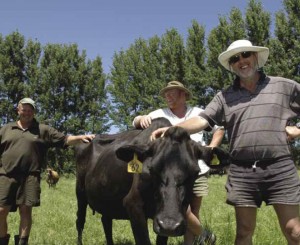You must be logged in to post a comment.
Archive
‘Up to the early 1990s we were farming the conventional way, using a lot of high analysis fertilisers,’ recalls Selwyn. ‘Come spring time, we’d have the farm shut up with plenty of grass available. The cows would go in and eat it all so we’d apply nitrogen to grow it again, which would cause the cows to scour, then eventually lose condition…’
| Farm Type | Dairy |
|---|---|
| Farm Size | 80ha / 72ha run-off (45 effective) |
| Awards | Regional Winners of the Best Dairy Award, Ballance Farm Environment Awards, 2002 |
| Years of dicalcic use | 16 |
| Application (once a year) | 500kg/ha Dicalcic 10% Sulphur (0:4.3:0:10) + 500kg/ha Lime |
‘We’d then fire on more fertiliser so the grass would grow to make silage. But that meant we’d require a large supply of bloat bullets, as well as a drum of bloat oil a month. If we weren’t out in the paddocks checking the cows by 10:30am with our drench gun we’d begin losing them. We’d make the silage, but nothing would grow in the mean time, so we’d end up feeding it out early. We were double drenching magnesium as well because of the chronic grass stagger problem. In the autumn, the cows would be back on grass, but they wouldn’t be milking right, they’d be skinny by the time we dried off, and we’d end up with a high rate of empties because they wouldn’t hold that long. Then we’d start all over again… it was a vicious cycle producing milk.’
We were getting high production at the time with 3.5 Friesian cows/ha, but we weren’t making any money because of all the extra costs associated with it. It wasn’t sustainable. For a month I began researching different fertiliser products looking for an alternative way, and that’s when I learnt about dicalcic. It sounded ideal. When we told the consultant about wanting to change to it, he strongly opposed the idea and warned us we’d go bankrupt. But we had nothing to lose.
Within three weeks of applying the fi rst lot of dicalcic, we noticed the sickly yellow tinge disappear and the grass became a lot greener. The health problems changed quickly too. And over the period it’s continued to improve thanks also to the lower stocking rate and a change to the lighter Jersey herd. The breeding is a lot better, the bloat is down to about one case a year, and we haven’t had a case of staggers now for a long time. We’ve also stopped drenching all together, we haven’t needed to for years.’
‘Changing the health of the stock has helped make this operation more sustainable,’ says Gordon. ‘When we were running a higher stocking rate, there was more pressure on the cows, but lowering it to around 2.5/ha has meant we’re getting better performance out of each one now, as well as eliminating the stress. We used to go to discussion groups and our cows would be the top producing. We’ve dropped back a bit now, but we’re making more money.’




 520 Maharakeke Rd, Waipukurau
520 Maharakeke Rd, Waipukurau

 0800 80 65 65 /
06 858 8567
0800 80 65 65 /
06 858 8567 06 8588018
06 8588018
Leave a Reply